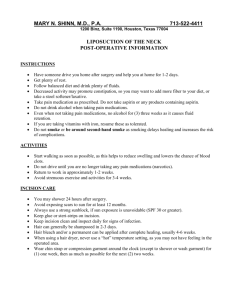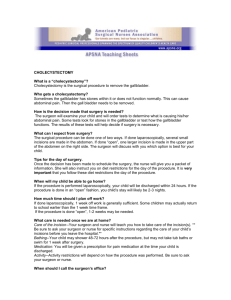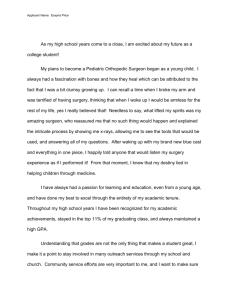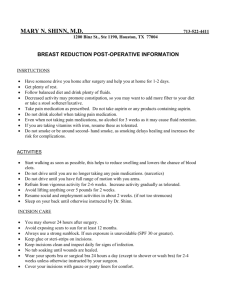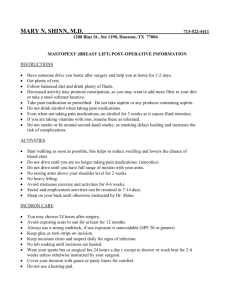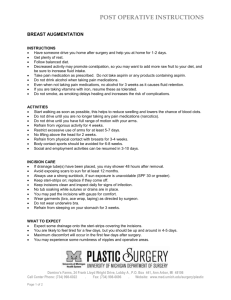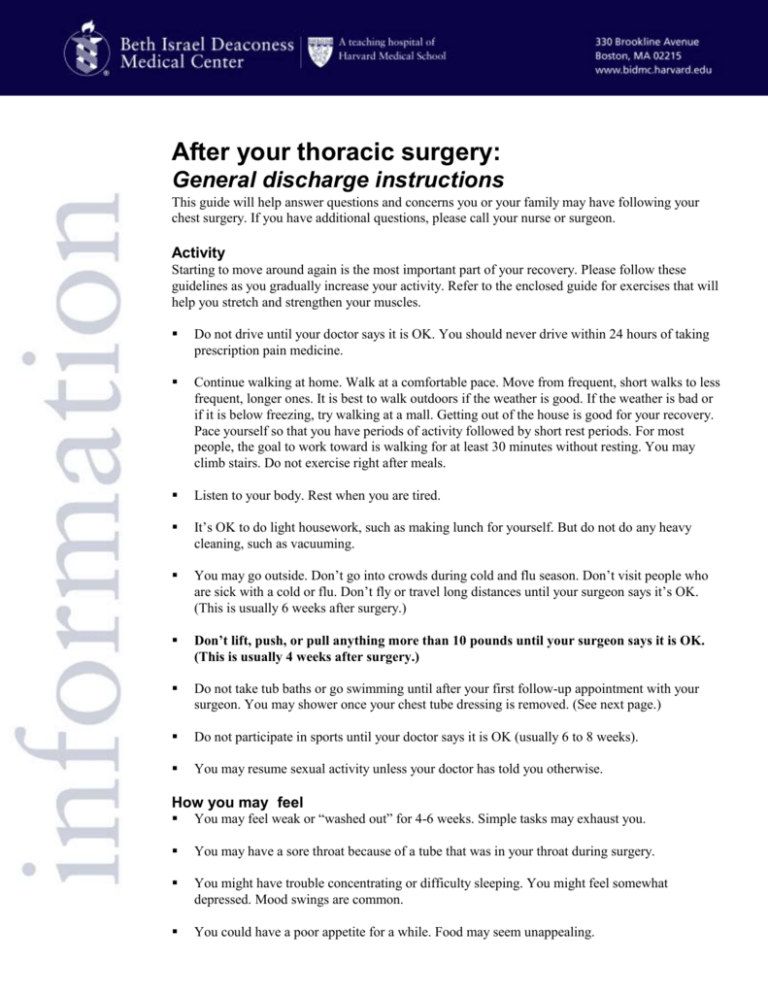
After your thoracic surgery:
General discharge instructions
This guide will help answer questions and concerns you or your family may have following your
chest surgery. If you have additional questions, please call your nurse or surgeon.
Activity
Starting to move around again is the most important part of your recovery. Please follow these
guidelines as you gradually increase your activity. Refer to the enclosed guide for exercises that will
help you stretch and strengthen your muscles.
Do not drive until your doctor says it is OK. You should never drive within 24 hours of taking
prescription pain medicine.
Continue walking at home. Walk at a comfortable pace. Move from frequent, short walks to less
frequent, longer ones. It is best to walk outdoors if the weather is good. If the weather is bad or
if it is below freezing, try walking at a mall. Getting out of the house is good for your recovery.
Pace yourself so that you have periods of activity followed by short rest periods. For most
people, the goal to work toward is walking for at least 30 minutes without resting. You may
climb stairs. Do not exercise right after meals.
Listen to your body. Rest when you are tired.
It’s OK to do light housework, such as making lunch for yourself. But do not do any heavy
cleaning, such as vacuuming.
You may go outside. Don’t go into crowds during cold and flu season. Don’t visit people who
are sick with a cold or flu. Don’t fly or travel long distances until your surgeon says it’s OK.
(This is usually 6 weeks after surgery.)
Don’t lift, push, or pull anything more than 10 pounds until your surgeon says it is OK.
(This is usually 4 weeks after surgery.)
Do not take tub baths or go swimming until after your first follow-up appointment with your
surgeon. You may shower once your chest tube dressing is removed. (See next page.)
Do not participate in sports until your doctor says it is OK (usually 6 to 8 weeks).
You may resume sexual activity unless your doctor has told you otherwise.
How you may feel
You may feel weak or “washed out” for 4-6 weeks. Simple tasks may exhaust you.
You may have a sore throat because of a tube that was in your throat during surgery.
You might have trouble concentrating or difficulty sleeping. You might feel somewhat
depressed. Mood swings are common.
You could have a poor appetite for a while. Food may seem unappealing.
All these feelings and reactions are normal and should go away in a short time. If they do not,
contact your primary care doctor or surgeon.
Incisions and dressings
You may have a small incision on the side (mini-thoracotomy), a large incision that goes from the
back to the front of the chest (open thoracotomy), or several very small incisions (video assisted
thoracic surgery, or VATS.) These are surgical incisions. In most cases, you will not have a dressing
over these incisions. Small paper strips (steri-strips) support these incisions as they heal.
In addition, you will have an incision where your chest tube was inserted. This incision is covered
with a dressing for 48 hours after the chest tube is removed.
Please follow these instructions regarding your incisions.
Care of chest tube dressing
Do not shower while the dressing is in place.
The dressing is taken off 48 hours after your chest tube is removed. This may be done in the
hospital or at home. Your nurse will give you more information about removing this dressing.
After the dressing is removed, leave the area open to air if possible. In some cases, a small
amount of drainage may come from this site. You may use a small, clean gauze or Band-Aid to
protect your clothing if you wish. If there is a lot of drainage from this area, or if the drainage is
foul-smelling, please contact your surgeon.
Care of surgical incisions and chest tube incision
If you have steri-strips on your incisions (thin paper strips), do not remove them. They will fall
off on their own. If they do not, your surgeon will remove them at your next visit.
You may gently wash away dried material around your incisions with mild soap and water,
unless your doctor has told you otherwise. We recommend unscented Dove, Basis, or Ivory. Pat
incisions dry with a clean towel. Do not use any ointments, lotions, alcohol, or creams on the
incisions.
Before you go home, you or your family member should look at your incisions with the nurse.
You will want to know what your incisions look like so that you can tell if there any changes
that should be reported to your doctor. If you have a thoracotomy (large incision in the back and
chest), it is normal to feel a firm ridge along the incision.
Avoid direct sun exposure to any incision.
As noted above, the chest tube incision may drain a small amount of fluid. However, your
surgical incisions should not have any drainage. If you see fluid or other material coming from
your surgical incisions, please contact your surgeon.
You may see redness on the upper part of the back. This is normal.
Call your surgeon if you notice any of the following signs of infection related to your incisions:
Increased redness (some redness is normal)
Increased warmth
Increased swelling
Increased tenderness
Any fluid coming out of your surgical
Foul smelling drainage from your
incisions
chest tube incision
Fever of 101 or more
Your bowels
Constipation is a common side effect of prescription pain medicine. If needed, you may take a
stool softener (such as Colace, one capsule 1 to 3 times per day) or gentle laxative (such as Milk
of Magnesia, 1 tablespoon, 1 to 2 times per day). You can get both of these medicines without a
prescription.
Food and drink
There are no restrictions on your diet. But you may have a decreased appetite. Let your surgeon
know if loss of appetite is severe. It is important that you take in enough nutrition to allow your
body to heal.
Do not drink alcohol until you no longer need prescription pain medicine.
.
Pain management
It is normal to feel some discomfort/pain following surgery. Although your chest incision may
be in the back or side, the pain is often felt in the front of the chest or breast. These pains may
be sharp or you may feel a tingling sensation.
As you begin to move around, you may have increased discomfort in the muscles around your
incisions.
You will receive a prescription from your surgeon for pain medicine to take by mouth. It is
important to take enough medicine so that you are able to stay as active as possible. Most
patients take some prescription pain medicine for 2-4 weeks at home.
Your surgeon may also recommend ibuprofen (Motrin) for pain. Unless you have stomach
problems or have been told not to take ibruprofen, you should take this along with your
prescription medication. This medication works differently from the narcotic pain medication
and should always be taken with food.
Your pain medicine will work better if you take it before your pain gets too severe. If you are
experiencing no pain, it is OK to skip a dose of pain medicine or take a smaller dose.
You may decrease the pain medicine dose by taking fewer pills each time (for example, move
from taking 2 tablets to 1 or ½ tablet at a time). Do what works best for you.
Don’t be discouraged if you need more medicine on some days than others. This is common.
Gradually, you should be able to take less and less pain medicine and still be comfortable.
Your pain should lessen over time. If you find the pain is getting worse instead of better, please
contact your surgeon.
If you have trouble sleeping because of pain, try taking pain medicine before bed.
Remember to use your “cough pillow” for splinting when you cough or when you are doing
your deep breathing exercises. Exhale with any exertion or when you change position.
If you experience any of the following, please contact your surgeon:
severe, sharp pain or any severe pain that is not relieved with medicine
pain that is getting worse over time
pain accompanied by fever of 101 or more
a drastic change in the nature or quality of your pain
Medications
Take all the medicines you were on before the operation just as you did before, unless you have
been told differently. If you have any questions about medicine, please call your surgeon.
In some cases, you will have a prescription for antibiotics or other medication.
When to call for help
Your surgeon will tell you when you
should be seen for an appointment.
Please call our surgical office to
schedule your appointment.
Call 617-632-8383
Here is a summary of symptoms you should note.
Call 911 for immediate help if you have:
extreme difficulty breathing
fainting or extreme dizziness
Call a doctor as noted if you develop:
Problems with your incisions (call your surgeon):
increased redness (some redness is normal)
increased swelling
fluid coming out of your surgical incisions
fever of 101 or more
increased warmth
increased tenderness
foul-smelling drainage from your chest tube
incision
Problems with pain (call your surgeon)
severe, sharp pain or any severe pain not
relieved with medicine
pain with fever of 101 or more
pain that is getting worse over time
a drastic change in the nature or quality of your
pain
Other symptoms
palpitations (call your surgeon)
constipation (call your surgeon)
depression or upsetting feelings (call your primary care doctor)
difficulty eating or drinking (call your primary care doctor)
difficulty sleeping (call your primary care doctor)
Activity guidelines following thoracic
surgery
This sheet gives information about exercises that will help you increase your activity
safely and comfortably following thoracic surgery. There are three types of exercises to
practice: breathing, shoulder movements, and walking.
General Guidelines
If you feel severe pain with any exercise, stop the activity and consult your
doctor, nurse, or physical therapist.
Keep good posture with all activities, making sure your shoulders are even
and you are not leaning toward your surgical side.
As the days go by, doing your exercises and becoming more active will get easier. If
you are having a lot of difficulty, please speak to your surgeon.
Breathing exercises
Breathing exercises are important to keep your lungs healthy. They help keep your
lungs clear and prevent infections that can occur after surgery. Perform these exercises
10 times every hour while in the hospital, and 2-3 times per day at home.
Deep breathing
Sit up in bed or in a chair with good
posture.
Place one hand on your abdomen and one
hand on your chest.
Breathe in deeply so that your abdomen
moves out against your hand while the
hand on your chest remains still.
Breath out slowly with your lips pursed (as
though you were whistling) as the hand
over your abdomen moves in slowly.
Coughing
Segmental breathing
Sit up in bed or in a chair with good
posture.
Hold a pillow against your incision.
Take a deep breath and cough twice.
(If coughing is too painful, “huff” by
forcing out air as though you were
panting.)
Place your hand over a particular area
of your lung.
Breathe out, and press down firmly on
this area.
Take a deep breath in and try to direct
air toward your hand.
Hold your breath for 5 seconds, exhale
slowly, and repeat.
Repeat the exercise on different areas
of the lung.
Shoulder exercises
Shoulder exercises will stretch and strengthen your muscles to restore normal movement
as your muscles heal after surgery. These exercises should be performed while deep
breathing (as you have learned using the first exercise on this sheet). These exercises
should be repeated 5-10 times, 2-3 times per day.
Raise arms to front
You may do this exercise standing,
lying in bed, or sitting with your back
against a chair. (Keep your hips,
shoulders and head against the back of
the chair.)
With thumbs pointed up, raise arms in
front of you and up toward your head.
(Breathe in.)
Hold arms up for 5 seconds.
Lower arms slowly. (Breathe out.)
Raise arms to side
Side stretch
Side rotation
You may do this exercise standing,
lying in bed, or sitting with your back
against a chair. (Keep your hips,
shoulders, and head against the back
of the chair.)
With thumbs pointed up, raise arms
out to your sides. (Breathe in.)
Hold arms up for 5 seconds.
Slowly lower arms down. (Breathe
out.)
Sit in a chair with good posture.
Place hands behind your head. (If this
is too painful, place arms down at your
side.)
Slowly bend to one side and hold for 5
seconds.
Slowly return to upright and repeat to
the other side.
Sit in chair with good posture.
Turn shoulders and chest to the right
without moving legs.
Hold position for 5 seconds.
Repeat, turning to the left.
Shoulder stretch
Begin sitting in a chair or standing
with hands together in front of chest.
Raise arms up, keeping hands together.
(Breathe in.)
Bring hands apart, straighten arms,
and rotate palms outwards.
Bring shoulder blades together while
lowering arms down. (Breathe out.)
Walking program
A walking program is important for you to build up endurance, increase circulation in
your legs, and keep your lungs clear. Walk at a comfortable pace. Work on increasing
how long you are walking.
Everyone will progress at a different speed. If you meet with a physical therapist, he or
she may use this chart to describe a program that is right for you.
Week 1
Minutes
Times/day
Week 2
Minutes
Times/day
Week 3
Minutes
Times/day
Week 4
Minutes
Times/day
Week 5
Minutes
Times/day
This material was developed by clinicians from rehabilitation services at Beth Israel Deaconess Medical Center. It is produced and
distributed by the Beth Israel Deaconess Learning Center. ©2005, Beth Israel Deaconess Medical Center. All rights reserved.
MC0985, 1/05

